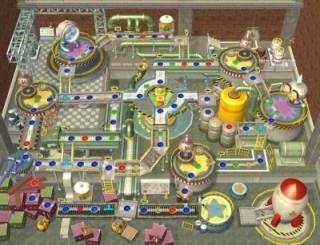Overview
 Mario Party 6
Mario Party 6Board games are a form of tabletop gaming that use a flat play surface with figures or markers to indicate mechanics like player progress or enemy movement. Board games frequently also use cards and dice to support the game's mechanics. Board games can also use a theme to make the mechanics easier to learn, as well as making the game more fun. They can be both competitive and cooperative, sometimes even in the same game.
Tabletop board games range from theme-free games like Chess and Go to theme-heavy ultra-complicated beasts like the Lovecraft-themed Arkham Horror. There are many adaptations (Catan, Carcassonne, Monopoly) and clones (Clubhouse Games, Words With Friends) of tabletop board games for game consoles and handhelds, as well as original video game-only designs (Culdcept, Mario Party) that use board game mechanics as a starting point and use the medium become more mathematically or mechanically complex. Culdcept has complex mathematics integrated into the mechanics, and both Culdcept and Mario Party have modular board designs that would be difficult or impossible to reproduce on a tabletop.
History
Board games have a history stretching back thousands of years, as early as ancient Egypt and Mesopotamia/Iraq/Babylon some 5,000 years ago. Some of the ancient board games that are still played through to the present day include Chess, which originated in 6th century India; Tic-Tac-Toe, which originated in Egypt over 3,000 years ago; Go, which originated in China over 2,000 years ago; Shogi (Japanese chess), which originated in Japan nearly 1,000 years ago; and Backgammon, which originated in Iran/Persia over 4,000 years ago. Some of these ancient board games, most notably Chess and Go, formed the basis for various modern video game genres, including the strategy and role-playing genres.
Log in to comment